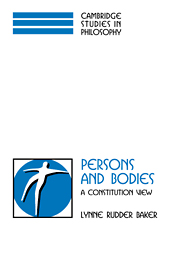5 - Personal Identity over Time
Published online by Cambridge University Press: 05 June 2012
Summary
There are two central questions about what it is to be a person. One is synchronic: In virtue of what is something a person at a given time? The other is diachronic: In virtue of what is there a single person at two different times? To put the diachronic question another way: Assuming that a person S is considered at time t and a person S′ is considered at time t′ in virtue of what is person S identical to person S′? So far, I have sheared off the question of what it is for x to be a person from the related, and much discussed, question of what it is for x and y to be the same person considered at two times. My answer to the synchronic question was that to be a person is to have a first-person perspective, where I gave an account of what a first-person perspective is; and to be a human person (nonderivatively) is to be a person constituted by a human organism.
Turn now to the diachronic question, the question of personal identity over time: In virtue of what is a person P1, at t1 the same person as person P2, at t2? All the candidate answers that I know to the question about identity of persons over time (including my own answer) are either clearly false or not very illuminating. I want now to canvas various answers, and show where they fall down, and then offer my own answer – in the not-very-illuminating category.
- Type
- Chapter
- Information
- Persons and BodiesA Constitution View, pp. 118 - 146Publisher: Cambridge University PressPrint publication year: 2000



